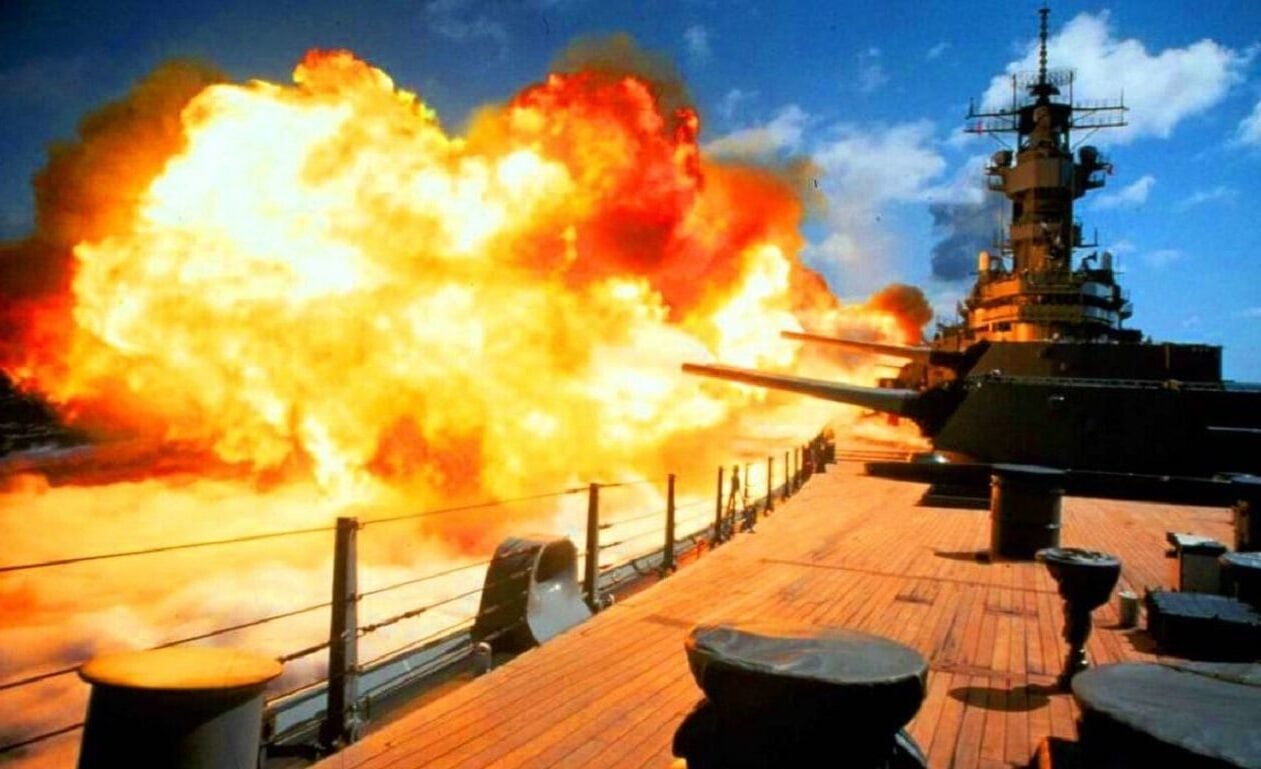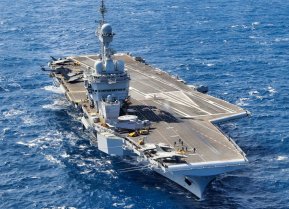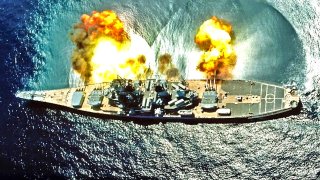How the U.S. Navy Sent 4 Retired Iowa-Class Battleships to Fight North Korea
As part of the naval mobilization in the Korean War, USS Iowa (BB-61) was reactivated in July 1951, and she sailed for Korean waters in March 1952.
The Navy Sent the Iowa-class Battleships Back to War in Korea - In the early summer of 1945, victory in the Pacific wasn't ensured – and that didn't change until the United States dropped the two atomic bombs on Japan, which finally resulted in the end of the Second World War.
At the time, the U.S. Navy had almost 3,400,000 officers and sailors on duty, while the fleet consisted of 1,200 major ships.
Within five years, the active duty personnel had shrunk to 375,000, and 90 percent of the U.S. Navy's personnel were discharged to civilian life. Hundreds of the warships that played a significant role in America's victory – as well as dozens more that were only completed after the hostilities ended – were placed in the reserve fleet.
That included three of the four completed Iowa-class battleships – the largest battle wagons ever built for the U.S. Navy – while two more were under construction were canceled and later broken up.
Only the USS Missouri (BB-63), the last of the four Iowa-class battleships to be completed, remained in service.
She conducted largely uneventful training and operational cruises until suffering a grounding accident in January 1950. That did not slow down the warship in the least, and she was ready when the U.S. Navy needed her again.
Iowa-Class Battleships: Back to War
The conflict in Korea essentially rose out of the "unfinished business" of the Second World War. The Soviet Union, which had remained neutral in the war in the Pacific until August 1945, accepted the surrender of Japan when the Red Army had advanced just north of the 38th parallel in Korea.
In an odd twist of fate, while Germany was divided by the victors, Japan was not – yet, Korea was. The Soviets helped establish a communist regime in the north, while the United States backed a pro-western government in the south.
Both claimed sovereignty over the entire country, and it set the stage for a civil war.
The stalemate was broken on June 25, 1950. The United States, which had initially declared Korea to be outside its defense perimeter – which likely resulted in a green light from Communist China and the Soviet Union for North Korea to strike – resulted in the Korean War.
The Iowa-class Was There
Later that year, as the United States became engaged in the conflict, USS Missouri was displaced to the region. She arrived just west of Kyūshū on September 14, 1950, and served as the flagship of Rear Admiral Allan Edward Smith. As the first American battleship to reach Korean waters, she bombarded Samchok on September 15 in an attempt to divert troops and attention from the Incheon landings. USS Missouri served two tours of duty in Korea, where she provided shore bombardment.
Return of USS Wisconsin
BB-63 wasn't the only of the Iowa-class battleships to see service in the war. Her sister ship USS Wisconsin (BB-64) was reactivated in 1950, and served two tours of duty, assisting South Korean and UN forces by providing call fire support and by shelling enemy targets
In December 1951, USS Wisconsin participated in a coordinated air-surface bombardment of Wonsan to neutralize selected North Korean targets in its area. The battleship then shifted her bombardment station to the western end of Wonsan harbor, hitting boats and small craft in the inner swept channel with her 5-inch (127 mm) guns during the afternoon and helping forestall attempts to assault the friendly-held islands nearby. USS Wisconsin then made an anti-boat sweep to the north, firing her 5-inch batteries on suspected boat concentrations. She next provided gunfire support to UN troops operating at the bombline until 22 December, when she rejoined a U.S. Navy carrier task force.
USS Iowa Was There
As part of the naval mobilization, USS Iowa (BB-61) was reactivated in July 1951, and she sailed for Korean waters in March 1952.
In early April of that year, she relieved her sister ship USS Wisconsin, and became the flagship of Vice Admiral Robert P. Briscoe, Commander of the Seventh Fleet In October 1952, USS Iowa was serving as flagship for the Commander, Seventh Fleet, and she engaged in 43 gun strikes on targets in the areas of Wonsan, Songjin, Kojo, Chaho, Toejo, Simpo, Hungnam and northern Inchon North Korea, and in 27 bombline operations.
During these operations, 16,689 rounds were fired from her main and secondary batteries on enemy installations. This action established eligibility for the United Nations Service Medal and the Korean Service Medal with one bronze star.
USS New Jersey Played a Role as Well
USS New Jersey (BB-62) was also recommissioned in November 1950. She provided fire support and in the fall of 1952 took part in coast raiding of North Korean transportation facilities – striking bridges, road, and rail installations at Wonsan, Hungnam, Tanchon, Iowon, Songjin, and Chongjin. The sortie left four bridges destroyed, a number more badly damaged, while two marshaling yards were damaged. BB-62 was active in the closing days of the war in July 1953, during which time she fired one of the most concentrated bombardments of her Korean duty.

For nine hours the first day and for seven the second, USS New Jersey's guns opened fire on gun positions and bunkers on Hodo Pando and the mainland with telling effect. At least ten enemy guns were destroyed in the barrage, while many more were damaged.
A number of caves and tunnels employed by the North Koreans were also sealed. USS New Jersey further smashed radar control positions and bridges at Kojo on July 13, and was once more on the east coast bombline July 23-24 to support South Korean troops near Kosong.
The four Iowa-class battleships that were built to bring victory in the Pacific in World War II truly brought out their big guns for Korea.
Author Experience and Expertise
Peter Suciu is a Michigan-based writer. He has contributed to more than four dozen magazines, newspapers, and websites with over 3,200 published pieces over a twenty-year career in journalism. He regularly writes about military hardware, firearms history, cybersecurity, politics, and international affairs. Peter is also a Contributing Writer for Forbes and Clearance Jobs. You can follow him on Twitter: @PeterSuciu.
All images are Creative Commons.


